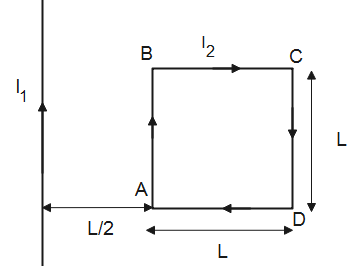Answer
366k+ views
Hint: The wire and the loop both have current flowing through them and hence a magnetic field is developed due to both. The force acting between both elements depends on the currents in the wire and loops, distance between wire and loop and the length of the loop. According to the direction of force, the resultant will be the vector sum of all forces acting on the sides of the loop.
Formulas used:
$F=\dfrac{{{\mu }_{0}}{{I}_{1}}{{I}_{2}}}{2\pi r}\times l$
Complete step-by-step solution:
The force between two straight wires is given by-
$F=\dfrac{{{\mu }_{0}}{{I}_{1}}{{I}_{2}}}{2\pi r}\times l$ - (1)
Here, $F$ is the force acting between the wires
${{\mu }_{0}}$ is the permeability of free space
${{I}_{1}}$ is the current in one wire
${{I}_{2}}$ is the current flowing through the second wire
$l$ is the length of the element on which the force acts
$r$ is the distance between the wires
The force acting on AD and BC is equal and opposite and hence will cancel out each other.
The force acting on AB will be, from eq (1),
$\begin{align}
& {{F}_{1}}=\dfrac{{{\mu }_{0}}{{I}_{1}}{{I}_{2}}}{2\pi \dfrac{L}{2}}L \\
& \Rightarrow {{F}_{1}}=\dfrac{2{{\mu }_{0}}{{I}_{1}}{{I}_{2}}}{2\pi } \\
\end{align}$
The force acting on DC will be, from eq (1),
$\begin{align}
& {{F}_{2}}=\dfrac{{{\mu }_{0}}{{I}_{1}}{{I}_{2}}}{2\pi \left( L+\dfrac{L}{2} \right)}L \\
& \Rightarrow {{F}_{2}}=\dfrac{2{{\mu }_{0}}{{I}_{1}}{{I}_{2}}}{2\pi (3)} \\
\end{align}$
Using the right hand thumb rule which states that if the thumb represent the current in a straight wire, then the fingers represent the direction of magnetic field, the direction of force on AB and DC is different, therefore, the total force on the loop due to the straight wire is-
$F={{F}_{1}}-{{F}_{2}}$
We substitute values in the above equation to get,
$\begin{align}
& F=\dfrac{2{{\mu }_{0}}{{I}_{1}}{{I}_{2}}}{2\pi }-\dfrac{2{{\mu }_{0}}{{I}_{1}}{{I}_{2}}}{2\pi (3)} \\
& \Rightarrow F=\dfrac{2{{\mu }_{0}}{{I}_{1}}{{I}_{2}}}{3\pi } \\
\end{align}$
Therefore, the total force acting on the loop is $\dfrac{2{{\mu }_{0}}{{I}_{1}}{{I}_{2}}}{3\pi }$. Hence, the correct option is (C).
Note: Since the current in the loop is flowing in the clockwise direction, a south pole is formed. While the magnetic field due to the current in the wire is in the plane of the paper for the loop, hence a north pole is formed. Therefore, a resultant attractive force exists between the wire and loop.
Formulas used:
$F=\dfrac{{{\mu }_{0}}{{I}_{1}}{{I}_{2}}}{2\pi r}\times l$
Complete step-by-step solution:
The force between two straight wires is given by-
$F=\dfrac{{{\mu }_{0}}{{I}_{1}}{{I}_{2}}}{2\pi r}\times l$ - (1)
Here, $F$ is the force acting between the wires
${{\mu }_{0}}$ is the permeability of free space
${{I}_{1}}$ is the current in one wire
${{I}_{2}}$ is the current flowing through the second wire
$l$ is the length of the element on which the force acts
$r$ is the distance between the wires
The force acting on AD and BC is equal and opposite and hence will cancel out each other.
The force acting on AB will be, from eq (1),
$\begin{align}
& {{F}_{1}}=\dfrac{{{\mu }_{0}}{{I}_{1}}{{I}_{2}}}{2\pi \dfrac{L}{2}}L \\
& \Rightarrow {{F}_{1}}=\dfrac{2{{\mu }_{0}}{{I}_{1}}{{I}_{2}}}{2\pi } \\
\end{align}$
The force acting on DC will be, from eq (1),
$\begin{align}
& {{F}_{2}}=\dfrac{{{\mu }_{0}}{{I}_{1}}{{I}_{2}}}{2\pi \left( L+\dfrac{L}{2} \right)}L \\
& \Rightarrow {{F}_{2}}=\dfrac{2{{\mu }_{0}}{{I}_{1}}{{I}_{2}}}{2\pi (3)} \\
\end{align}$
Using the right hand thumb rule which states that if the thumb represent the current in a straight wire, then the fingers represent the direction of magnetic field, the direction of force on AB and DC is different, therefore, the total force on the loop due to the straight wire is-
$F={{F}_{1}}-{{F}_{2}}$
We substitute values in the above equation to get,
$\begin{align}
& F=\dfrac{2{{\mu }_{0}}{{I}_{1}}{{I}_{2}}}{2\pi }-\dfrac{2{{\mu }_{0}}{{I}_{1}}{{I}_{2}}}{2\pi (3)} \\
& \Rightarrow F=\dfrac{2{{\mu }_{0}}{{I}_{1}}{{I}_{2}}}{3\pi } \\
\end{align}$
Therefore, the total force acting on the loop is $\dfrac{2{{\mu }_{0}}{{I}_{1}}{{I}_{2}}}{3\pi }$. Hence, the correct option is (C).
Note: Since the current in the loop is flowing in the clockwise direction, a south pole is formed. While the magnetic field due to the current in the wire is in the plane of the paper for the loop, hence a north pole is formed. Therefore, a resultant attractive force exists between the wire and loop.
Recently Updated Pages
In a flask the weight ratio of CH4g and SO2g at 298 class 11 chemistry CBSE

In a flask colourless N2O4 is in equilibrium with brown class 11 chemistry CBSE

In a first order reaction the concentration of the class 11 chemistry CBSE

In a first order reaction the concentration of the class 11 chemistry CBSE

In a fermentation tank molasses solution is mixed with class 11 chemistry CBSE

In a face centred cubic unit cell what is the volume class 11 chemistry CBSE

Trending doubts
Which are the Top 10 Largest Countries of the World?

Difference Between Plant Cell and Animal Cell

Give 10 examples for herbs , shrubs , climbers , creepers

Fill the blanks with the suitable prepositions 1 The class 9 english CBSE

Difference between Prokaryotic cell and Eukaryotic class 11 biology CBSE

Write a letter to the principal requesting him to grant class 10 english CBSE

Change the following sentences into negative and interrogative class 10 english CBSE

Name 10 Living and Non living things class 9 biology CBSE

List some examples of Rabi and Kharif crops class 8 biology CBSE




